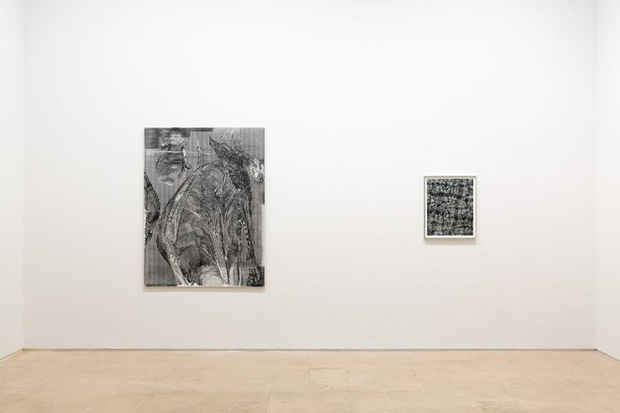Eileen Quinlan & Cheyney Thompson “Displacements and Dead Trees”
Miguel Abreu Gallery

This event has ended.
Miguel Abreu Gallery presents Eileen Quinlan and Cheyney Thompson’s two-person exhibition, Displacements and Dead Trees.
Eileen Quinlan’s sequence of new, mostly black and white photographs of trees and scenes from nature is here presented in dialogue with a suite of paintings by Cheyney Thompson from his recent Displacement series. The exhibition inaugurates this new body of work comprised of medium-scaled, chiefly black and white works, which the artist has developed over the past year.
As a dedicated literalist operating in the tradition of ‘what you see is what you get’ in painting, Thompson tends to astutely foreground the layers that participate in the subtle articulation of his works. Perhaps at no time in his career, however, has this plain truth and disposition been more nakedly visible and generously functioning than in this Displacement series. An initial layer of sprayed gesso is applied to the support, before a stencil made of small squares in grid formation is affixed to the linen and painted black, thus activating the retinal dimension of the flat surface. This simple and fundamental structure, one steeped in the history of art and of Thompson’s medium of choice, then becomes the ground for gestures of material and graphic displacement, for attempts at discrete acts of liberation from the imposed arrangement made possible by the very paired down elements at hand. A snake-like silicone tool is used to at times extend squares into lines, at others initiate more dramatic painterly movements and smear effects. Surprising shapes of varied intensities ensue from these decidedly physical processes that always leave in plain sight the trace of their own making. Forms often seem to float in a state of suspension and produce illusions of three dimensional space, a space that remains directly connected, however, to its two dimensional sources. Finally and unexpectedly, as the insistent eye wonders and lingers upon these works, the contours of recognizable things, as if by chance, might begin to appear: a falling bird here, a tree trunk, and a branch there. In one of the paintings, a yellow gradient is introduced like an intrusion of color from the outside.
Allegorically speaking, if the notion of displacement can suggest the unwarranted movement of objects all the way indeed to that of actual people, as it obviously does today, Thompson reminds us with these at once humble and compellingly executed paintings that it is feasible, in art, to mentally as well as materially escape from established formal circumstances. And as is well known, art at its best is an invitation to see something new that can be turned, eventually, into a model for decisive action.
On the far back wall of the gallery, installed adjacent to the final painting in the show, is Quinlan’s close up picture of the doubly exposed bark of a tree. The lush and luminous black and white photograph, printed on fiber paper, veers towards abstraction and produces a haptic sensation that today few paintings are able to achieve. Perpendicular to it hangs a glorious vertical winter landscape with the sun glaring through tree branches and into the camera. To the right, further, appears the only color photograph in the space, a faded image of foliage against the sky. The installation concludes with the outcome of a broken process, that of an old Polaroid film sliding in and out of a camera and failing to get exposed to what lies in front of it. What instead appears to the viewer resembles a sand dune in the desert, a mirage of a place on earth where mirages are expected to occur.
There is a sense of melancholia emanating from Quinlan’s diverse, yet thematically consistent installation across both spaces. If an elegiac determination to capture particular fragments of our endangered planet, as well as to reveal and manipulate the chemical and electronic processes of the photographic remains firmly in place, a feeling of uncertainty emerges as to whether the means at the artist’s disposal can offer much more than their very limitation in manifesting slices of life in the universe.
Media
Schedule
from September 10, 2020 to October 31, 2020